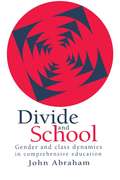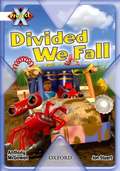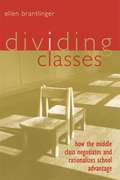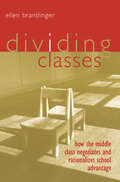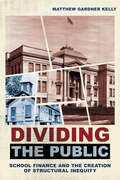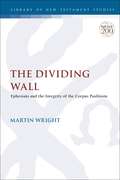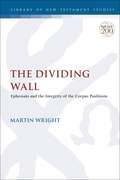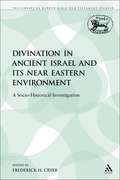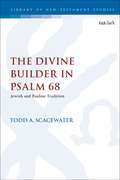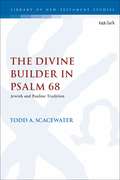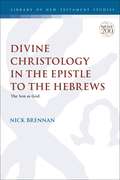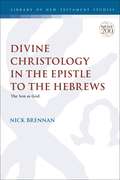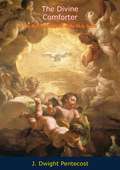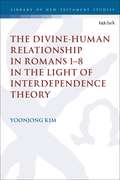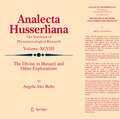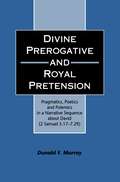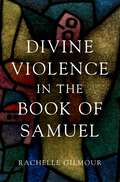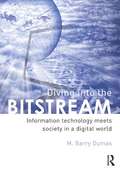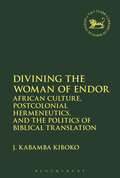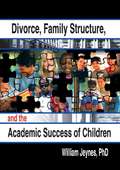- Table View
- List View
Divide And School: Gender And Class Dynamics In Comprehensive Education
by John AbrahamFirst published in 1995. Routledge is an imprint of Taylor & Francis, an informa company.
Divide And School: Gender And Class Dynamics In Comprehensive Education
by John AbrahamFirst published in 1995. Routledge is an imprint of Taylor & Francis, an informa company.
Divided We Fall (PDF)
by Anthony Mcgowan Jon StuartIn Divided We Fall and The Balloon Team, Max, Cat, Ant and Tiger realize that they have to work together if they want to get themselves out of some difficult scrapes. In Fee Fie Fo. . . MUM! quarrelling twins Sam and Samantha have to work together to play the giant in Jack and the Beanstalk. Also in this cluster, find out more about how music and bands and football in the two non fiction books, Let's Form a Band and The Beautiful Team. Each book comes with notes for parents that highlight tricky words or concepts in the books, prompt questions and suggest a range of follow-up activities. The Working as a Team Guided Reading Notes provide step-by-step guided reading support for each book in the Working as a Team cluster, togetherwith guidance about comprehension, assessment for learning and vocabulary enrichment. Hands-on follow-up activities and cross-curricular links are also provided for each book.
Dividing Classes: How the Middle Class Negotiates and Rationalizes School Advantage
by Ellen BrantlingerIn this study of the school system of an Indiana town, Ellen Brantlinger studies educational expectations within segments of the middle class that have fairly high levels of attainment. Building on her findings, she examines the relationship between class structure and educational success. This book asserts the need to look beyond poor peoples' values and aspirations--and rather to consider the values of dominant groups--to explain class stratification and educational outcomes.
Dividing Classes: How the Middle Class Negotiates and Rationalizes School Advantage
by Ellen BrantlingerIn this study of the school system of an Indiana town, Ellen Brantlinger studies educational expectations within segments of the middle class that have fairly high levels of attainment. Building on her findings, she examines the relationship between class structure and educational success. This book asserts the need to look beyond poor peoples' values and aspirations--and rather to consider the values of dominant groups--to explain class stratification and educational outcomes.
Dividing the Public: School Finance and the Creation of Structural Inequity (Histories of American Education)
by Matthew Gardner KellyIn Dividing the Public, Matthew Gardner Kelly takes aim at the racial and economic disparities that characterize public education funding in the United States. With California as his focus, Kelly illustrates that the use of local taxes to fund public education was never an inadvertent or de facto product of past practices, but an intentional decision adopted in place of well-known alternatives during the Progressive Era, against past precedent and principle in several states.From efforts to convert expropriated Indigenous and Mexican land into common school funding in the 1850s, to reforms that directed state aid to expanding white suburbs during the years surrounding World War II, Dividing the Public traces, in intricate detail, how a host of policies connected to school funding have divided California by race and class over time. In bringing into view the neglected and poorly understood history of policymaking connected to school finance, Kelly offers a new story about the role public education played in shaping the racially segregated, economically divided, and politically fragmented world of the post-1945 metropolis.
The Dividing Wall: Ephesians and the Integrity of the Corpus Paulinum (The Library of New Testament Studies)
by Martin WrightThis book argues for the integrity of the Pauline Corpus as a complex, composite text. Martin Wright critiques the prevailing tendency to divide the Corpus in two, separating the undoubtedly authentic letters from those of disputed authorship. Instead, he advocates for a renewed canonical hermeneutic in which the Corpus as a whole communicates Paul's legacy, and the authorship of individual letters is less important, stressing that that current preoccupations with authorship have a distorting effect on exegesis, and need to be reconsidered. Wright uses Ephesians as a focal text to illustrate the exegetical potential of this approach. He critically investigates the history of the prevailing hermeneutics of pseudonymity, with particular attention to the theological and confessional partiality with which it is often inflected. And constructively, he proposes a new hermeneutical model in which the Pauline Corpus is read as a continuous interpretative dialogue, leaving the question of authorship to one side. In two substantial exegetical studies, Wright offers new readings of passages from Ephesians and other Pauline letters, amplifying the proposed approach and illustrating its value.
The Dividing Wall: Ephesians and the Integrity of the Corpus Paulinum (The Library of New Testament Studies)
by Martin WrightThis book argues for the integrity of the Pauline Corpus as a complex, composite text. Martin Wright critiques the prevailing tendency to divide the Corpus in two, separating the undoubtedly authentic letters from those of disputed authorship. Instead, he advocates for a renewed canonical hermeneutic in which the Corpus as a whole communicates Paul's legacy, and the authorship of individual letters is less important, stressing that that current preoccupations with authorship have a distorting effect on exegesis, and need to be reconsidered. Wright uses Ephesians as a focal text to illustrate the exegetical potential of this approach. He critically investigates the history of the prevailing hermeneutics of pseudonymity, with particular attention to the theological and confessional partiality with which it is often inflected. And constructively, he proposes a new hermeneutical model in which the Pauline Corpus is read as a continuous interpretative dialogue, leaving the question of authorship to one side. In two substantial exegetical studies, Wright offers new readings of passages from Ephesians and other Pauline letters, amplifying the proposed approach and illustrating its value.
Divination in Ancient Israel and its Near Eastern Environment: A Socio-Historical Investigation (The Library of Hebrew Bible/Old Testament Studies)
by Frederick H. CryerIn this revealing study, the author suggests that ancient Israel was a 'magic society' like those around it, and similar in many respects to a number of magic-using 'savage' societies studied by modern social anthropology. Although the Old Testament attempts to distinguish between priestly and prophetic divination, this distinction was not sharply drawn in ancient times. References to divination in fact are found in all genres of Israelite literature, implying that many of these practices were performed throughout Israelite society. 'Cryer's investigation of divination in ancient Israel is a masterful synthesis of social and historical analyses of an important yet neglected topic' (Ronald E. Simkins, Catholic Biblical Quarterly).
The Divine Builder in Psalm 68: Jewish and Pauline Tradition (The Library of New Testament Studies)
by Todd A. ScacewaterThe problem of Psalm 68:19 (Masoretic Text) in Ephesians 4:8 has a rich history of interpretation; particular focus has been placed on Jewish and Pauline interpretations of the psalm, and the Jewish exegetical tradition that reads Moses as the one who ascends Mount Sinai to receive and give the law. Todd Scacewater suggests a second tradition, henceforth unnoticed, that interprets Psalm 68 eschatologically. While both traditions are significant, Scacewater maintains that the eschatological tradition provides a better matrix through which to understand Paul's use of the psalm.Scacewater argues that another key for understanding Pauline use of the psalm is the divine builder topos, which is pervasive in the ancient Near East, utilized in Psalm 68, and evident in Paul's understanding of the psalm as he applies it to Christ, the eschatological divine builder. Discussing the context of Ephesians, the building of the Temple and the trope of the divine builder, and Psalm 68's position in early/late Judaism and Ephesians, Scacewater contributes to a new methodology for studying how the New Testament authors interpreted and appropriated Hebrew Scriptures.
The Divine Builder in Psalm 68: Jewish and Pauline Tradition (The Library of New Testament Studies)
by Todd A. ScacewaterThe problem of Psalm 68:19 (Masoretic Text) in Ephesians 4:8 has a rich history of interpretation; particular focus has been placed on Jewish and Pauline interpretations of the psalm, and the Jewish exegetical tradition that reads Moses as the one who ascends Mount Sinai to receive and give the law. Todd Scacewater suggests a second tradition, henceforth unnoticed, that interprets Psalm 68 eschatologically. While both traditions are significant, Scacewater maintains that the eschatological tradition provides a better matrix through which to understand Paul's use of the psalm.Scacewater argues that another key for understanding Pauline use of the psalm is the divine builder topos, which is pervasive in the ancient Near East, utilized in Psalm 68, and evident in Paul's understanding of the psalm as he applies it to Christ, the eschatological divine builder. Discussing the context of Ephesians, the building of the Temple and the trope of the divine builder, and Psalm 68's position in early/late Judaism and Ephesians, Scacewater contributes to a new methodology for studying how the New Testament authors interpreted and appropriated Hebrew Scriptures.
Divine Christology in the Epistle to the Hebrews: The Son as God (The Library of New Testament Studies)
by Nick BrennanNick Brennan investigates the depiction of the Son's divine nature in the Epistle to the Hebrews; despite little attention being directly given to the Son's divinity in recent study of Hebrews, Brennan argues that not only is the Son depicted as divine in the Epistle, but that this depiction ranges outside the early chapters in which it is most often noted, and is theologically relevant to the pattern of the Author's argument.Beginning with a survey of the state of contemporary scholarship on the Son's divinity in Hebrews, and a discussion of the issues connected to predicating divinity of the Son in the Epistle, Brennan analyses the application of Old Testament texts to the Son which, in their original context, refer to God (1:6; 10–12), and demonstrates how the Pastor not only affirms the Son's divinity but also the significance of his exaltation as God. He then discusses how Heb 3:3, 4 witnesses to the divinity of the Son in Hebrews, explores debates on the relation of the Son's “indestructible life” (Heb 7:16) to his divinity, and demonstrates how two key concepts in Hebrews (covenant and sonship) reinforce the Son's divinity. Brennan thus concludes that the Epistle not only portrays the Son as God, but does so in a manner which is a pervasive aspect of its thought, and is theologically salient to many features of the Epistle's argument.
Divine Christology in the Epistle to the Hebrews: The Son as God (The Library of New Testament Studies)
by Nick BrennanNick Brennan investigates the depiction of the Son's divine nature in the Epistle to the Hebrews; despite little attention being directly given to the Son's divinity in recent study of Hebrews, Brennan argues that not only is the Son depicted as divine in the Epistle, but that this depiction ranges outside the early chapters in which it is most often noted, and is theologically relevant to the pattern of the Author's argument.Beginning with a survey of the state of contemporary scholarship on the Son's divinity in Hebrews, and a discussion of the issues connected to predicating divinity of the Son in the Epistle, Brennan analyses the application of Old Testament texts to the Son which, in their original context, refer to God (1:6; 10–12), and demonstrates how the Pastor not only affirms the Son's divinity but also the significance of his exaltation as God. He then discusses how Heb 3:3, 4 witnesses to the divinity of the Son in Hebrews, explores debates on the relation of the Son's “indestructible life” (Heb 7:16) to his divinity, and demonstrates how two key concepts in Hebrews (covenant and sonship) reinforce the Son's divinity. Brennan thus concludes that the Epistle not only portrays the Son as God, but does so in a manner which is a pervasive aspect of its thought, and is theologically salient to many features of the Epistle's argument.
The Divine Comforter: The Person and Work of the Holy Spirit
by J. Pentecost“...he shall give you another Comforter, that he may abide with you forever.”—John 14:16Personal, intimate fellowship between the believer and the Spirit is essential for spiritual growth. God’s purpose in redemption is to bring believers into fellowship with Himself. He has therefore given the believer a mind to know Him, a heart to love Him, and a Person to commune with him—the person of the Holy Spirit.Internationally known author and Bible teacher J. Dwight Pentecost examines the Person and ministry of the Holy Spirit in this thorough yet practical work that seeks to know the Spirit’s work in daily life. “It is my desire,” he writes, “to bring you face-to-face with a Person so that you might enjoy fellowship with Him.”Some of the subjects discussed in the eighteen chapters of this work include the nature of the Spirit, the filling of the Spirit, the baptism of the Spirit, the Spirit and the inspiration of Scripture, the witness of the Spirit to the world, and gifts of the Spirit.
The Divine-Human Relationship in Romans 1–8 in the Light of Interdependence Theory (The Library of New Testament Studies #635)
by Yoonjong KimYoonjong Kim analyses the divine-human relationship in Paul's theology, focusing on Paul's portrayal of the relationship in Romans 1–8. Kim stresses that previous studies of this relationship have not paid sufficient attention to the fact that it is not static, but rather exhibits progression and development towards a goal. To address the significance of the human agent's role in the relationship, Kim employs a social psychological theory – interdependence theory – offering a consistent analytic framework for diagnosing the interactions in a dyadic relationship in terms of the dependency created by each partner's expectations of outcomes.Kim explores several key stages of the divine-human relationship and the direction in which the relationship develops throughout Romans 1–8, in order to highlight the significance of the human partners in the course of the development. He focuses in particular on betrayal (1.18–3.20), restoration (3.21–26; 5.1–11), the oppressive relationship with Sin (5.12–8.11), and the investment for the future (8.12–39), and concludes that although the foundation of the relationship rests on God's initiative, the divine outworking guides the relationship so that it facilitates mutual participation of the human partners in the restoration and development of the relationship toward the ultimate goal.
The Divine-Human Relationship in Romans 1–8 in the Light of Interdependence Theory (The Library of New Testament Studies)
by Yoonjong KimYoonjong Kim analyses the divine-human relationship in Paul's theology, focusing on Paul's portrayal of the relationship in Romans 1–8. Kim stresses that previous studies of this relationship have not paid sufficient attention to the fact that it is not static, but rather exhibits progression and development towards a goal. To address the significance of the human agent's role in the relationship, Kim employs a social psychological theory – interdependence theory – offering a consistent analytic framework for diagnosing the interactions in a dyadic relationship in terms of the dependency created by each partner's expectations of outcomes.Kim explores several key stages of the divine-human relationship and the direction in which the relationship develops throughout Romans 1–8, in order to highlight the significance of the human partners in the course of the development. He focuses in particular on betrayal (1.18–3.20), restoration (3.21–26; 5.1–11), the oppressive relationship with Sin (5.12–8.11), and the investment for the future (8.12–39), and concludes that although the foundation of the relationship rests on God's initiative, the divine outworking guides the relationship so that it facilitates mutual participation of the human partners in the restoration and development of the relationship toward the ultimate goal.
The Divine in Husserl and Other Explorations (Analecta Husserliana #98)
by Angela Ales BelloIn the first part of The Divine in Husserl and Other Explorations a description is provided of Husserl’s method in order to explain how he deals with the question of God from a philosophical perspective. The results from this investigation are compared with the main contributions of the philosophers of the past. The second part focuses on the theme of religion as developed by Husserl in order to grasp the meaning of religious lived-experiences. Through an archeological excavation Husserl teaches us how to go to the bottom of the sacred and the divine in order to pinpoint their features and to comprehend their religious configurations in history. In the third part one can find the application of husserlian hyletics and noetics to the field of the archaic sacred and of the different religious experiences. Some particular themes are treated such as ecstasy, contemplation, incarnation, and the relationship between the human being and the God from a philosophical and a religious point of view.
Divine Perogative and Royal Pretension: Pragmatics, Poetics and Polemics in a Narrative Sequence about David (2 Samuel 5.17-7.29) (The Library of Hebrew Bible/Old Testament Studies)
by Donald F. MurrayIn this close reading of a text central to the story of David, the author, using the tools of linguistic pragmatics and poetics, exposes the text's promotion of a prophetic-based ideology, through a polemical rhetoric that polarizes David and Yahweh around the opposed notions of king (melek) and leader (nagid). He then goes on to analyse the context, in ancient Near Eastern royal ideology and in Samuel, for how the text develops this opposition, and finally reflects on its promulgation of the supreme mediacy of the prophetic word.
Divine Violence in the Book of Samuel
by Rachelle GilmourMuch of the drama, theological paradox, and interpretive interest in the Book of Samuel derives from instances of God's violence in the story. The beginnings of Israel's monarchy are interwoven with God's violent rejection of the houses of Eli and of Saul, deaths connected to the Ark of the Covenant, and the outworking of divine retribution after David's violent appropriation of Bathsheba as his wife. Whilst divine violence may act as a deterrent for violent transgression, it can also be used as a model or justification for human violence, whether in the early monarchic rule of Ancient Israel, or in crises of our contemporary age. In Divine Violence in the Book of Samuel, Rachelle Gilmour explores these narratives of divine violence from ethical, literary, and political perspectives, in dialogue with the thought of Immanuel Kant, Martha Nussbaum and Walter Benjamin. She addresses such questions as: Is the God of Samuel a capricious God with a troubling dark side? Is punishment for sin the only justifiable violence in these narratives? Why does God continue to punish those already declared forgiven? What is the role of God's emotions in acts of divine violence? In what political contexts might narratives of divine violence against God's own kings, and God's own people have arisen? The result is a fresh commentary on the dynamics of transgression, punishment, and their upheavals in the book of Samuel. Gilmour offers a sensitive portrayal of God's literary characterization, with a focus on divine emotion and its effects. By identifying possible political contexts in which the narratives arose, God's violence is further illumined through its relation to human violence, northern and southern monarchic ideology, and Judah's experience of the Babylonian exile.
Divine Violence in the Book of Samuel
by Rachelle GilmourMuch of the drama, theological paradox, and interpretive interest in the Book of Samuel derives from instances of God's violence in the story. The beginnings of Israel's monarchy are interwoven with God's violent rejection of the houses of Eli and of Saul, deaths connected to the Ark of the Covenant, and the outworking of divine retribution after David's violent appropriation of Bathsheba as his wife. Whilst divine violence may act as a deterrent for violent transgression, it can also be used as a model or justification for human violence, whether in the early monarchic rule of Ancient Israel, or in crises of our contemporary age. In Divine Violence in the Book of Samuel, Rachelle Gilmour explores these narratives of divine violence from ethical, literary, and political perspectives, in dialogue with the thought of Immanuel Kant, Martha Nussbaum and Walter Benjamin. She addresses such questions as: Is the God of Samuel a capricious God with a troubling dark side? Is punishment for sin the only justifiable violence in these narratives? Why does God continue to punish those already declared forgiven? What is the role of God's emotions in acts of divine violence? In what political contexts might narratives of divine violence against God's own kings, and God's own people have arisen? The result is a fresh commentary on the dynamics of transgression, punishment, and their upheavals in the book of Samuel. Gilmour offers a sensitive portrayal of God's literary characterization, with a focus on divine emotion and its effects. By identifying possible political contexts in which the narratives arose, God's violence is further illumined through its relation to human violence, northern and southern monarchic ideology, and Judah's experience of the Babylonian exile.
Diving Into the Bitstream: Information Technology Meets Society in a Digital World
by Barry M. DumasNationwide, and indeed worldwide, there has been a growing awareness of the importance of access to information. Accordingly, information technology (IT), broadly defined and its role beyond the internal workings of businesses has leapt into the social consciousness. Diving into the Bitstream distinguishes itself by weaving together the concepts and conditions of IT. What distinguishes these trends is their focus on the impacts of IT on societies, and the responsibilities of IT’s creators and users. The author pulls together important, often complex issues in the relationships among information, information technologies, and societal constructs. The text explores a synopsis of these issues that are foundations for further consideration.
Diving Into the Bitstream: Information Technology Meets Society in a Digital World
by Barry M. DumasNationwide, and indeed worldwide, there has been a growing awareness of the importance of access to information. Accordingly, information technology (IT), broadly defined and its role beyond the internal workings of businesses has leapt into the social consciousness. Diving into the Bitstream distinguishes itself by weaving together the concepts and conditions of IT. What distinguishes these trends is their focus on the impacts of IT on societies, and the responsibilities of IT’s creators and users. The author pulls together important, often complex issues in the relationships among information, information technologies, and societal constructs. The text explores a synopsis of these issues that are foundations for further consideration.
Divining the Woman of Endor: African Culture, Postcolonial Hermeneutics, and the Politics of Biblical Translation (The Library of Hebrew Bible/Old Testament Studies #644)
by J. Kabamba KibokoAn examination of the language of divination in the Hebrew Bible, particularly in 1 Samuel 28:3-25-the oft-called “Witch of Endor” passage. Kiboko contends that much of the vocabulary of divination in this passage and beyond has been mistranslated in authorized English and other translations used in Africa and in scholarly writings. Kiboko argues that the woman of Endor is not a witch. The woman of Endor is, rather, a diviner, much like other ancient Near Eastern and modern African diviners. She resists an inner-biblical conquest theology and a monologic authoritarian view of divination to assist King Saul by various means, including invoking the spirit of a departed person, Samuel. Kiboko carries out a Hebrew word-study shaped by the theories of Mikhail M. Bakhtin regarding the utterance, heteroglossia, and dialogism in order to understand the designative, connotative, emotive, and associative meanings of the many divinatory terms in the Hebrew Bible. She then examines 1 Samuel 28 and a number of prior translations thereof, using the ideological framework of African-feminist-postcolonial biblical interpreters and translation theories to uncover the hidden ideology or transcript of these translations. Finally, using African contextual/cultural hermeneutics and cross-cultural translation theory, Kiboko offers new English, French, and Kisanga translations of this passage that are both faithful to the original text and more appropriate to an inculturated-liberation African Christian hermeneutic, theology, and praxis.
The Division Book: A Progression of Division Skills (PDF)
by Jillian CockingsPrimary school division book
Divorce, Family Structure, and the Academic Success of Children
by William JeynesTrace the influence of family factors on children's emotional and educational well-being!The effect of family changes on children's academic success is a new subject for study. Divorce, Family Structure, and the Academic Success of Children is a comprehensive volume that brings research on this hotly debated topic up to date. With clear tables and incisive arguments, it is a single-volume reference on this vexing sociocultural problem. Divorce, Family Structure, and the Academic Success of Children offers a close look at the historical background and current theory of this field of study. But it is more than a compendium of known facts and completed studies. It examines issues of appropriate methodology and points out concerns for planning future research. Divorce, Family Structure, and the Academic Success of Children summarizes current knowledge of the effects of various influences on children's emotional and educational well-being, including: divorce and remarriage single-parent families nontraditional family structures race socioeconomic status mobility Educators, theorists, sociologists, and psychologists will find this volume an essential resource. With hundreds of useful references and clear organization, it presents new ideas in an easy-to-use format that makes it an ideal textbook as well.
